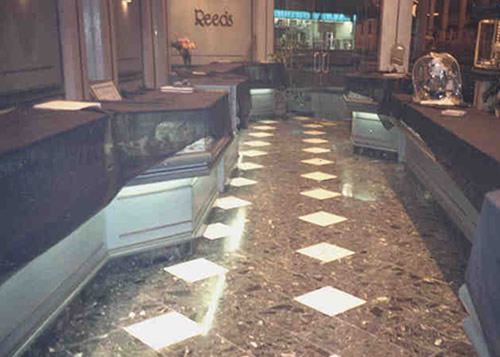Our Stripping and Refinishing Process will Clean Your Marble and Limestone Floors.
We Then Apply a Shiny Protective Sealer.
We also Buff and Polish Any Type of Stone Flooring.




Special attention will be given to all areas that need to be taped and protected.
All marble and limestone flooring will be machine cleaned using a 160lb.Mercury 175 r.p.m. floor scrubber equipped with a silicon tynex brush. This stiff nylon brush with different length bristles will completely strip the floor removing all wax, dirt, and grime. All edges and corners will be hand scrubbed. This cleaning method will not harm the marble flooring and all of the cleaning chemicals are biodegradable and environmentally safe.
After the marble or limestone floors are stripped clean, all of the solutions are removed. The floors are then given a complete mopping and thorough rinsing with a neutralizing solution.
When the marble or limestone floors have completely dried they are vacuumed with an Electrolux Olympia Vacuum cleaner with a 3 layer dust filter. This will insure a perfectly clean floor for the application of the marble floor sealers and marble floor finishes.
Now that all the marble or limestone floors are clean and dust free, the first coat of Spartan Marble Sealer will be applied. This coat will take approximately 20-30 minutes to dry. The second coat will then be applied to all the marble flooring. As the porosity of marble varies, additional coats may be needed, or the floor may need to be buffed at 2000 r.p.m. to achieve maximum depth and color. Your Marble or Limestone floors will be clean and shiny.
This is a process similar to spray buffing that uses a weighted floor machine equipped with a steel wool pad. Crystallizer is sprayed onto a small section of the floor and buffed with a steel wool pad to create a catalytic reaction. The heat generated by the steel wool pad causes a chemical reaction between the crystallizing formula and the calcium in the stone creating a new, chemically enhanced surface.
This will bring forth the marble’s natural depth and color.
Contact us with any questions or problems concerning your Connecticut floor cleaning, commercial and residential floor stripping, floor refinishing, and contract floor maintenance needs.
The following article is from he Marble Institute of America…..Thank you.
Sealing Natural Stone According to The Marble Institute of America (MIA)
Should natural stone be sealed? In some cases it makes perfect sense to seal the stone. Once properly sealed, the stone will be protected against everyday dirt and spills. In other cases, it is best to leave the stone untreated. Topical sealers can alter the surface texture and finish, as well as build up on the surface creating a layer that is less durable than the stone.
The Marble Institute of America’s position on sealers is as follows:
The Marble Institute of America (MIA) recognizes the benefits that sealers can provide in certain applications. MIA recommends that care be exercised in the application of any chemical to a stone’s surface. Although normally innocent in and of themselves, some sealers have reportedly reacted with some cleaning/maintenance chemicals and/or with components within the stone surface, causing some reactions.
Dimension Stone Design Manual, Version VI, page 19
Factors to consider prior to determining if the stone should be protected:
- What is the hardness, density, and durability of the stone?
- How porous is the stone and how fast will it absorb a liquid (also referred to as the absorption coefficient)?
- Is the stone expected to be in frequent contact with a staining agent?
- What type of finish was applied to the surface? For example, a polished surface is more resistant to staining than a honed surface.
- Will the sealant affect the color or other aesthetics of the stone?
- If a resin was applied to the stone, how will the sealant react with the resin?
- Where is the stone located (e.g. countertop, floor, wall, foyer, bathroom, etc)? Residential or Commercial?
- What type of maintenance program has or will the stone been subjected to?
- The type of stone, its finish, its location, and how it is maintained all need to be considered when determining how to protect the stone. The MIA recommends that these factors be reviewed with the end-user during the decision making process.
Different types of Products
Make sure you understand the differences between the common product types available on the market. The products typically fall into two major categories: Topical Sealer/Coatings and Impregnators.
Topical Sealers are coatings (film formers) designed to protect the surface of stone against water, oil, and other contaminants. They are formulated from natural wax, acrylic, and other plastic compounds. Coatings are classified into two general types: strippable and permanent:
Strippable coatings are formulated to be easily stripped or removed from the stone. These coatings are made of polymers such as acrylics, styrene, and polyethylene, and are usually water-based. Many of the janitorial coatings available on the market are water-based, polymer-type products designed for resilient tile floors and not for stone. Read the label carefully and/or consult with the Manufacturer prior to application.
Permanent coatings, once applied, are very difficult to remove. They’re made of solvent-based or water-based polymers such as polyurethane and epoxies. These are not normally recommended for stone.
When a topical sealer is applied, the maintenance program often shifts from a program focused on the stone care to a program focused on the maintenance of the sealer (for example: stripping and reapplication).
If a coating is used on a countertop where food is to be used, verify the coating is approved for food use.
Impregnators, water- or solvent-based, penetrate below the surface and become repellents. Impregnators keep contaminants out, but do not stop the interior moisture from escaping. These products are considered “breathable ,” meaning they allow for vapor transmission. They are generally hydrophobic (water-repelling), may also be oliophobic (oil-repelling):
- Hydrophobic impregnators are formulated to repel only water and water-based chemicals. Fruit drinks, coffee, tea, and soda, for example, would be repelled by a hydrophobic impregnator.
- Oliophobic impregnators are designed to repel water and oil-based liquids. Cooking oil, grease, and body oils are examples of substances that would be repelled by an oliophobic impregnator.
An important distinction between oliophobic and hydrophobic impregnators is that an oliophobic impregnator is always hydrophobic, but a hydrophobic impregnator may not be oliophobic. Be sure to read sealer product labels carefully or contact the Manufacturer to determine if they are hydrophobic, oliophobic, or both.
Some products are also labeled as “oil-resistant,” but “oil-resistant” and “oil-repellent” are entirely different. An oil-resistant impregnator will only slow down the absorption of oil into the stone. An oil-repellent impregnator will prevent oil from entering the stone. Make certain that you’re buying the appropriate product for your particular application.
Topical Sealers vs. Impregnators (Advantages and Disadvantages)
How do you decide whether to use a coating or an impregnator to protect the stone? Both have advantages and disadvantages. The following summary should be studied carefully to help you choose the right product.
Topical Sealers – Advantages
- Topical sealers are generally economical. The initial application cost is relatively small.
- They’re usually easy to apply. Unskilled laborers can learn to apply them with a reasonable amount of training and practice.
- Topical sealers typically provide a sacrificial layer on the stone. This layer will take most of the wear on the stone.
- Certain topical sealers may provide added slip resistance.
- Some topical sealers can be applied below grade.
- These products provide various degrees of luster.
Topical Sealers – Disadvantages
- Since most topical sealers are typically softer than the stone itself, they will usually scratch, mar and scuff very easily, showing traffic patterns soon after application. This will require frequent buffing, burnishing, or reapplication.
- Topical sealers can build up and cause an unsightly appearance, giving an unnatural, wavy, plastic look to the stone.
- Poor quality topical sealers can turn yellow. This is especially true if the stone is exposed to ultraviolet (UV) light.
- Some topical sealers require frequent stripping and reapplication. The chemicals and abrasives used in the stripping process may cause damage to the stone. Typically, certain stripping pads and brushes can scratch softer stones. Some wax strippers can harm agglomerate stones by eating through the polyester resin binders they contain. Certain topical sealers may block the “breathing” capability of a stone. Moisture can become trapped below the surface and may lead to spalling.
Impregnators – Advantages
- Most impregnators won’t change the appearance of the stone.
- Impregnators typically don’t require frequent applications. Since the impregnator is below the surface, it will generally last several years before reapplication is necessary.
- Most impregnators aren’t affected by UV light because they’re absorbed below the surface where light can’t penetrate.
- Impregnators are typically hydrophobic, and some of them are oliophobic as well.
Impregnators – Disadvantages
- Impregnators that are solvent-based produce vapors during application. In some cases these vapors can be noxious and flammable.
- Some varieties of solvent-based impregnators are harmful to the environment, releasing large amounts of volatile organic compounds (VOCs). For this reason, the use of these impregnators is restricted in certain states. Also, some water-based impregnators may also contain harmful or toxic chemicals. Always check the material safety data sheet (MSDS) of the product before deciding whether to use it.
- Proper application of impregnators is generally more difficult than that of coatings. In many cases, training or professional consultation is recommended.
- The initial cost of most impregnators can relatively high.
- Generally, impregnators cannot be used below grade to resist hydrostatic pressure. Because the stone is still capable of breathing, water can be forced through the stone by pressure.
Other factors to consider:
- Exterior stones – Generally, topical sealers are not recommended in exterior applications, because they can trap moisture within the stone which may lead to surface deterioration during freeze/thaw cycles.
- Resined stones – In some situations, impregnating sealers applied to a resined stone will cause the material to cloud, discolor, or fade. While this is a new topic in the stone industry, some initial reports have indicated that the application of a color enhancer may hide the problem. Additionally, the problems have occurred with solvent-based vs. water-based impregnators. It is highly recommended that you consult with the Sealant Manufacturer prior to applying a sealer to a resined stone.
- Staff Education – How well does your staff understand the differences between sealers? Consider holding a training session on this topic. Some questions your staff should be able to answer include
- What are differences between a topical sealer and an impregnator? What are the advantages vs. disadvantages?
- How much sealer or impregnator do I need to complete the project?
- Is a single application sufficient or are multiple applications required?
- Will the product application change the appearance of the stone?
- How is natural stone maintained after treating?
- What factors should be considered prior to product selection? Is it necessary?
- Will sealing protect the stone from etching?
- Consumer Education – When discussing the pros and cons of sealers and/or impregnators with your consumers, advise the consumer to:
- Carefully review the ‘factors to be considered’ prior to treating (checklist from page 1).
- Read the Manufacturers Warranty and Instructions.
- Contact the Manufacturer prior to application if you are unsure or need clarification. The wood-working analogy of ‘measure twice, cut once’ applies.
- Consider the life span of the application (1-year, 2-years, 5-years, etc) – keep a log of each application with maintenance logs.
- Don’t switch from one product to another without fully understanding any potential issues. Not all product are alike – again, consult with the Manufacturers.
- Consult with your Stone Professional as necessary.
- Ask, does the stone need to be treated in the first place?
MIA Recommends:
Careful review of multiple factors (i.e. type of stone, its finish, its location, and how it will be maintained) be taken into consideration when determining how to protect the stone.
If the choice has been made to protect the stone with a sealer or impregnator, always consult with the Manufacturer/Distributor to advise and choose the appropriate sealing product.
This technical bulletin contains general guidelines. The Marble Institute of America and its Member companies are not responsible for any use or misuse that causes damage of any kind, including loss of rights, materials, and personal injury alleged to be caused directly or indirectly by the information contained in this document.
The MIA thanks MIA Member firms The National Center for Stone & Masonry Trades, Aqua Mix Inc., StoneTech Professional Inc., Miracle Sealants & Abrasives Company, as well as members of the MIA Board of Directors, Education Committee, and Technical Committee for their help and advice.
Contact us with any questions or problems concerning your Connecticut floor cleaning, commercial and residential floor stripping, floor refinishing, and contract floor maintenance needs.
